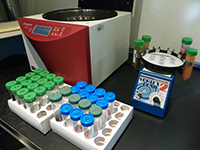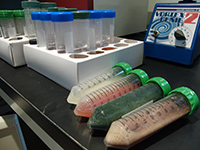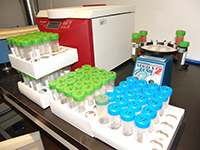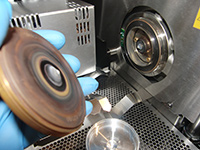

 |
 |
 |
 |
 |
 Researched and pioneered by Mike Adams (the "Health Ranger"), the world's leading scientist on the subject of selective affinity binding properties of foods, the Metals Capturing Capacity (MCC) describes the ability of any given food or dietary substance to bind with and "capture" a quantity of toxic elements such as lead, mercury, cadmium or even radioactive isotopes such as cesium-137.
Researched and pioneered by Mike Adams (the "Health Ranger"), the world's leading scientist on the subject of selective affinity binding properties of foods, the Metals Capturing Capacity (MCC) describes the ability of any given food or dietary substance to bind with and "capture" a quantity of toxic elements such as lead, mercury, cadmium or even radioactive isotopes such as cesium-137.
Until scientifically documented by Adams, the binding ability of foods has only been understood and described in vague terms with statements like, "Cilantro absorbs heavy metals" or "Zeolites can help detox heavy metals." Adams' research is now able to fully test these claims and document the actual micrograms per gram of toxic elements which are bound or "captured" by foods, superfoods, herbs and dietary substances. For the record, Adams has already documented that cilantro's reputation is vastly overstated: it actually performs very poorly in terms of metals affinity and binding.
Mike Adams' pioneering research now documents that nearly all foods containing natural insoluble fibers are able to easily bind with dietary mercury. This even includes, surprisingly, Doritos, as Doritos are based on GMO corn which naturally contains fibers. Virtually all grains, grasses, fruits and vegetables naturally bind with mercury with very high efficiency.
The practical application of this newfound knowledge is that people who are concerned about eating mercury in fish can now easily defend themselves against that dietary mercury by making sure they consume fresh fruit, bread, high-fiber vegetables or even a fiber supplement with that same meal. By doing so, they will vastly reduce their body's absorption of the mercury from the fish (greater than 99% in some cases). Transference of mercury out of the fish and into the dietary fibers is greatly enhanced by the presence of strong, healthy stomach acid. The more acidic the stomach acid, the greater the transference and "capturing" of mercury.
In other words, substances with high MCC numbers can be eaten together with contaminated foods to bind with and "capture" the toxic elements in the same meal. Mercury is the most easily captured toxic element, as mercury tends to stick to everything. Eating a meal of tuna together with a whole apple (fresh, raw and complete with its natural fibers) will help protect against the mercury in the tuna. The apple "captures" the mercury in the tuna and carries it out of the body in fecal matter. Chlorella and spirulina also have high selective affinity for certain toxic elements. Many algae products perform extremely well in this context.
THE SCIENCE BEHIND THE MCC
The MCC is described in units of micrograms per gram. An MCC of 15, for example, means the substance in question is able to capture and bind with 15 micrograms of the named element for every gram of the substance. Most MCC numbers are below 2, indicating very low natural affinity for toxic elements, but some dietary substances, foods, superfoods and supplements have remarkable natural affinity for certain elements. Their MCC numbers can rise to 50 or higher.
At Labs.NaturalNews.com, Adams does not publish the actual MCC numbers but instead translates them into easy-to-read visual charts that show MCC ranges from "none" to "extremely high." You can view examples of this right now at Labs.NaturalNews.com
Mike Adams, also director of the non-profit Consumer Wellness Center (www.ConsumerWellness.org), pioneered the methodology for determining the Metals Capturing Capacity of foods. He now directs the laboratory operations that continue to assess off-the-shelf food products for their MCC numbers. He has already made many new discoveries which he is busy documenting and writing up to be published in scientific papers.
DETERMINING THE MCC
The MCC is determined by subjecting candidate substances to a simulated digestion process using a synthetic acid and a process designed to simulate the time duration, acid content, temperature and physical motions of human digestion. The digestive fluids are spiked with a known quantity of toxic elements, allowing the candidate food substance an opportunity to bind with and "capture" the toxic elements.
This process is conducted using a long list of quality control safeguards such as using stock element solutions traceable back to NIST standards as well as using multiple control "blank spikes" to determine the baseline for zero capturing capacity.
Once digestion is complete, food solids are separated from liquids using a process designed to mimic the function of the intestinal walls. The resulting liquids are then subjected to atomic spectroscopy analysis via ICP-MS conducted at parts per billion (ppb) sensitivity. Adams uses high-end ICP-MS instrumentation outfitted with a Collision Reaction System running He gas as a collision gas to reduce polyatomic interferences and thereby vastly increase the detection limits of the system. Elements are then quantitatively measured using a mass-to-charge ration mass analyzer discrimination chamber.
The resulting element concentrations are compared to a blank spike containing no foods or other materials, and the difference between resulting concentrations in the tested substance liquid is the amount of toxic elements which were captured by the candidate food substance. This is all detailed with great precision by Adams using university-level laboratory protocols and calibrations.
MCC EARLY RESULTS:
In his pioneering research, Adams has already made many discoveries about metal affinity and capturing.
Metals Capturing Capacity data is published for hundreds of foods and dietary supplements at Labs.NaturalNews.com